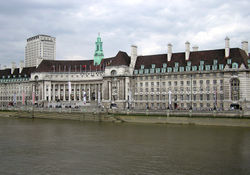London County Council
| London County Council | |
|---|---|
| Local government body for London | |

|
|
| Type | |
| Type | |
| History | |
| Established | 21 March 1889 |
| Disbanded | 1 April 1965 |
| Preceded by | Metropolitan Board of Works |
| Succeeded by | Greater London Council |
| Seats |
1889–1919: 118 councillors; 19 aldermen 1919–1949: 124 councillors; 20 aldermen 1949–1955: 129 councillors; 21 aldermen 1955–1965: 126 councillors; 21 aldermen |
| Elections | |
| bloc vote | |
|
Last election
|
1961 |
| Meeting place | |
 |
|
| County Hall, Lambeth | |
London County Council (LCC) was the principal local government body for the County of London throughout its existence from 1889 to 1965, and the first London-wide general municipal authority to be directly elected. It covered the area today known as Inner London and was replaced by the Greater London Council. The LCC was the largest, most significant and most ambitious English municipal authority of its day.
By the 19th century the City of London Corporation covered only a small fraction of metropolitan London. From 1855 the Metropolitan Board of Works (MBW) had certain powers across the metropolis, but it was appointed rather than elected. Many powers remained in the hands of traditional bodies such as parishes and the counties of Middlesex, Surrey and Kent. The creation of the LCC in 1889, as part of the Local Government Act 1888, was forced by a succession of scandals involving the MBW, and was also prompted by a general desire to create a competent government for the city, capable of strategising and delivering services effectively. While the Conservative government of the day would have preferred not to create a single body covering the whole of London, their electoral pact with Liberal Unionists led them to this policy. It was established as a provisional council on 31 January 1889 and came into its powers on 21 March 1889. Shortly after its creation a Royal Commission on the Amalgamation of the City and County of London considered the means for amalgamation with the City of London. Although this was not achieved, it led to the creation of 28 metropolitan boroughs as lower tier authorities to replace the various local vestries and boards in 1900; they assumed some powers of the LCC and shared others.
...
Wikipedia
